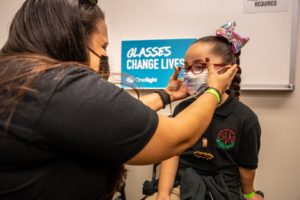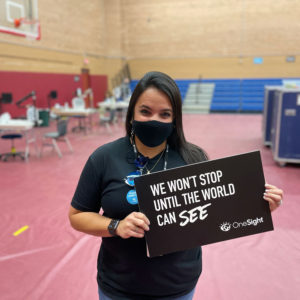Contacts vs Glasses: Which Is Right for You?
You’ve reached a crucial decision-making point. You’ve contacted an eye doctor, made it through an eye exam, and received a prescription to correct your vision—and now, it’s time to choose: contact lenses or glasses?
Glasses: Pros and Cons
Glasses are often the first choice for people receiving corrective vision care, as they tend to be simpler to use and require less maintenance compared to contacts. Glasses also tend to be cheaper since, if they are properly cared for, a pair of glasses can last for years (assuming that your prescription stays the same, of course). By contrast, most contacts need to be replaced periodically.

However, many people find glasses to be less convenient than contacts. Glasses are more likely to fall off, and can become broken or lost if they do. For people who have extremely active lifestyles or play sports, glasses might be a hindrance. Further, depending on the type of glasses, some styles have frames that can actually limit your field of vision slightly.
Glasses are also notoriously vulnerable to weather. Fog, rain, and cold temperatures can make life with glasses a nuisance for wearers.
Contacts: Pros and Cons
There are a variety of different types of contacts, including daily wear lenses, extended-wear lenses, and disposables. Because contacts are worn directly on top of the eye, they’re much less likely to fall out (although it can still occasionally happen), making them a more popular choice for people who move around a lot. Contacts also provide a more natural vision than glasses.

However, on a day-to-day basis, contacts tend to be a bit more high-maintenance than glasses. Depending on the type of contacts you choose, most will require that you take them out and clean them regularly. Contacts also come with a higher risk of eye infection or irritation in the event that something gets trapped beneath the lens, or the lenses aren’t properly cleaned.
When it comes to contact lenses vs. glasses, there’s no right answer—for most people, the choice largely comes down to their vision needs, lifestyle, and personal preference. Moreover, many people use both, and switch between the two depending on the situation.
OneSight is on a mission to help the world see better by bringing affordable vision care to those who need it most. Since 1988, we’ve reached 52+ million people worldwide, including lives served directly as well as people who now have ongoing access to vision care through permanent vision centers. Our strategy is focused on both meeting immediate needs and establishing long-term solutions, and involves a combination of charitable clinics and sustainable vision centers. Contact us for more information about how you can make a difference in ending the vision care crisis, or consider donating to support our work.